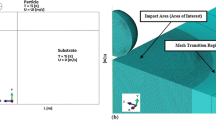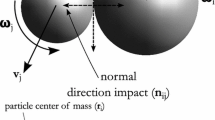Abstract
The use of targeted particulate jets for surface modification in advanced manufacturing processes such as shot-peening are now becoming widespread. The degree of precision now demanded, in tightly confined workspaces, dictates that these processes undergo deeper scrutiny, refinement and optimization, in particular to avoid unintended excessive normal and tangential impact forces and re-impact from the rebounding jet on secondary surfaces. This work focuses on the building block of a particulate jet, namely the inelastic impact of a particle with a surface. The governing equations for a general three-dimensional inelastic impact with unilateral stick-slip conditions are derived, with the objective being to extract the particle and target characteristics which control the forces induced on impact and the resulting post-impact trajectories. Quantitative and qualitative analyses are performed for different types of surfaces and allows analysts to make informed decisions on the choices of parameters in jets, in order to reduce trial and error procedures.




Similar content being viewed by others
Notes
We ignore gravity throughout the analysis. Furthermore, we will ignore any aerodynamic effects, such as drag and the Magnus effect, whereby a spinning particle with angular velocity \({\varvec{\omega }}\) and velocity \({\varvec{v}}_c\) creates unequal drag forces on the surface, since the points on the surface are traveling at unequal absolute speeds (\({\varvec{v}}_p={\varvec{v}}_{c}+{\varvec{\omega }}\times {\varvec{r}}_{c\rightarrow p}\)). We concentrate only on the instants directly before and after the impact event itself.
If one assumed that the surface’s velocity was zero, we would obtain \(v_{p,n}(t+\delta t)=-v_{p,n}(t)\mathcal{E}.\)
References
Afazov SM, Becker AA, Hyde TH (2012) Mathematical modeling and implementation of residual stress mapping from microscale to macroscale finite element models. J Manuf Sci Eng 134(2):021001–021001-11
Avci B, Wriggers P (2012) A DEM–FEM coupling approach for the direct numerical simulation of 3D particulate flows. J Appl Mech 79:010901-(1-7)
Bagherifard S, Giglio M, Giudici L, Guagliano M (2010). Experimental and numerical analysis of fatigue properties improvement in a titanium alloy by shot peening. In: Proceedings of ASME 49163; ASME 2010 10th Biennial conference on engineering systems design and analysis, vol 2, pp 317–322
Bolintineanu DS, Grest GS, Lechman JB, Pierce F, Plimpton SJ, Schunk PR (2014) Particle dynamics modeling methods for colloid suspensions. Comput Part Mech 1(3):321–356
Cante J, Davalos C, Hernandez JA, Oliver J, Jonsen P, Gustafsson G, Haggblad HA (2014) PFEM-based modeling of industrial granular flows. Comput Part Mech 1(1):47–70
Carbonell JM, Onate E, Suarez B (2010) Modeling of ground excavation with the particle finite element method. J Eng Mech ASCE 136:455–463
Chen Z, Yang F, Meguid SA (2014) Realistic finite element simulations of arc-height development in shot-peened almen strips. J Eng Mater Technol 136(4):041002–041002-7
Dirksen F, Anselmann M, Zohdi TI, Lammering R (2013) Incorporation of flexural hinge fatigue-life cycle criteria into the topological design of compliant small-scale devices. Precis Eng 37:531–541
Duran J (1997) Sands, powders and grains. An introduction to the physics of granular matter. Springer, New York
Elbella A, Fadul F, Uddanda SH, Kasarla NR (2012) Influence of shot peening parameters on process effectiveness. In: Proceedings ASME, 45196; vol 3: design, materials and manufacturing, parts A, B and C, pp 2015–2021
Fathi S, Dickens P, Khodabakhshi K, Gilbert M (2013) Microcrystal particles behaviour in inkjet printing of reactive nylon materials. J Manuf Sci Eng 135:011009. doi:10.1115/1.4023272
Labra C, Onate E (2009) High-density sphere packing for discrete element method simulations. Commun Numer Methods Eng 25(7):837–849
Leonardi A, Wittel FK, Mendoza M, Herrmann HJ (2014) Coupled DEM–LBM method for the free-surface simulation of heterogeneous suspensions. Comput Part Mech 1(1):3–13
Lum GZ, Teo TJ, Yang G, Yeo SH, Sitti M (2014) Integrating mechanism synthesis and topological optimization technique for stiffness-oriented design of a three degrees-of-freedom flexure-based parallel mechanism. Precis Eng 39:125–133
Onate E, Idelsohn SR, Celigueta MA, Rossi R (2008) Advances in the particle finite element method for the analysis of fluid-multibody interaction and bed erosion in free surface flows. Comput Methods Appl Mech Eng 197(19–20):1777–1800
Onate E, Celigueta MA, Idelsohn SR, Salazar F, Surez B (2011) Possibilities of the particle finite element method for fluid-soil-structure interaction problems. Comput Mech 48:307–318
Onate E, Celigueta MA, Latorre S, Casas G, Rossi R, Rojek J (2014) Lagrangian analysis of multiscale particulate flows with the particle finite element method. Comput Part Mech 1(1):85–102
Pöschel T, Schwager T (2004) Computational granular dynamics. Springer, Berlin
Rojek J, Labra C, Su O, Onate E (2012) Comparative study of different discrete element models and evaluation of equivalent micromechanical parameters. Int J Solids Struct 49:1497–1517. doi:10.1016/j.ijsolstr.2012.02.032
Rojek J (2014) Discrete element thermomechanical modelling of rock cutting with valuation of tool wear. Comput Part Mech 1(1):71–84
Wriggers P (2002) Computational contact mechanics. Wiley, New York
Zohdi TI (2012) Dynamics of charged particulate systems. Modeling, theory and computation. Springer, New York
Zohdi TI (2013) Numerical simulation of charged particulate cluster-droplet impact on electrified surfaces. J Comput Phys 233:509–526
Zohdi T (2014) Embedded electromagnetically sensitive particle motion in functionalized fluids. Comput Part Mech 1(1):27–45
Zohdi TI (2014) Rapid computation of statistically-stable particle/feature ratios for consistent substrate stresses in printed flexible electronics. J Manuf Sci Eng ASME (MANU-14-1476). doi:10.1115/1.4029327
Author information
Authors and Affiliations
Corresponding author
Rights and permissions
About this article
Cite this article
Zohdi, T.I. Modeling and simulation of the post-impact trajectories of particles in oblique precision shot-peening. Comp. Part. Mech. 3, 533–540 (2016). https://doi.org/10.1007/s40571-015-0048-5
Received:
Revised:
Accepted:
Published:
Issue Date:
DOI: https://doi.org/10.1007/s40571-015-0048-5




